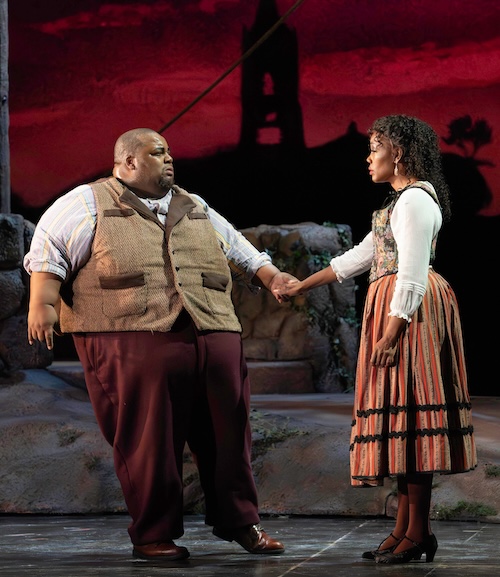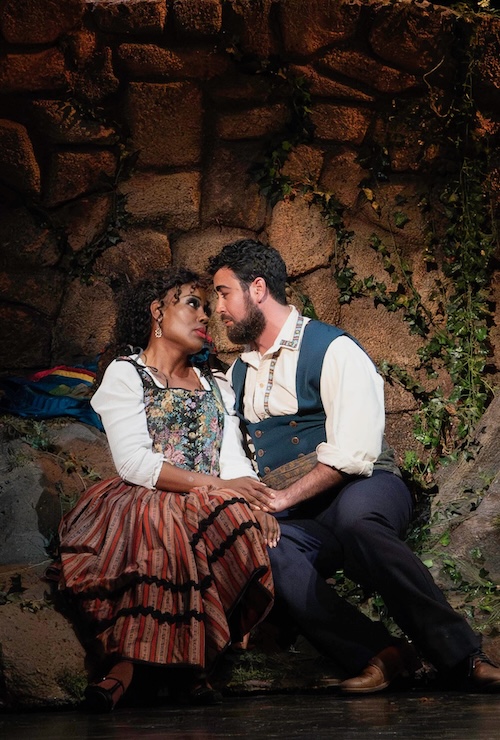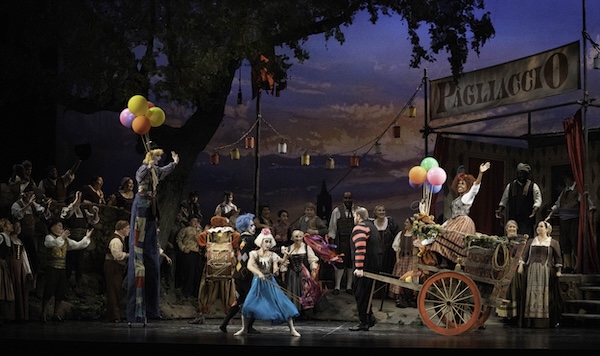FGO’s expanded “Pagliacci” serves up fiery verismo vocalism

Limmie Pulliam as Canio and Kearstin Piper Brown as Nedda in Florida Grand Opera’s production of Leoncavallo’s Pagliacci. Photo: Daniel Azoulay/FGO
Although conceived in two concise acts, Ruggiero Leoncavallo’s Pagliacci is grand opera writ large. Raging passions, love, betrayal, and murder course through this 1892 verismo drama.
Florida Grand Opera’s new production, which opened Saturday night at the Arsht Center, meets the work’s considerable vocal demands and theatricality on its own terms. Jeffrey Marc Buchman’s staging expands the score by adding additional music by Leoncavallo and other Neapolitan songs in the commedia dell’arte play within a play of the second act. If the opera were a timeless masterpiece of Verdi or Puccini, that would be an artistic desecration, but Pagliacci is not a truly great opera on that level. It is, however, a great piece of entertainment and Buchman’s expansion of the score brings even greater entertainment value for the audience.
The singers were clearly equal to the music’s challenges. In any production of Pagliacci, the role of the clown Canio is pivotal. Without a tenor who has the vocal strength and can command the stage the opera falls apart.
Rising tenor Limmie Pulliam certainly had the vocal heft and more for the protagonist. He is a portly individual which limits his stage activity to some extent. (Next to Pulliam, Luciano Pavarotti was comparatively svelte.) Clown antics were not part of his dramatic persona. He sang sitting down during most of the show, including much of the most famous aria “Vesti la giubba.”
Still, his immobility apart, Pulliam was impressive and moving in the role. Like the silent movie stars of long yesteryear, Pulliam’s facial expressions conveyed a huge emotional range from joy, humor and happiness to heartbreak and murderous rage. He certainly conveyed the clown’s conflicted personality and Buchman set him in tableaux that kept the emphasis on the libretto’s stormy interactions.
Above all, Pulliam’s tenor is the authentic article. His top range exudes power without strain or breaks between registers. He brought the ardent emotional turmoil of a man coming apart, while preparing to entertain a crowd of villagers, in his big Act I aria. From the most dulcet pianissimo to full throated outbursts of passion, Pulliam’s “Core’ngrato,” vaulted through the house with ringing fervor.
“Noi! Pagliaccio non son” was the cry of a broken man, vividly conveyed by Pulliam. After killing his wife Nedda and her lover Silvio and proclaiming “La commedia è finita’ (The comedy is finished), he sank to his knees in shame and despair as the curtain fell. Overcoming the limitations of his size, Pulliam managed to embody the opera’s drama.
Kearstin Piper Brown was a perky Nedda with a shiny vocal top and a dusky, mezzo-like lower register. Her birdsong aria “Stridono lasù” glistened and enchanted. Buchman’s added a pantomime to a Leoncavallo orchestral piece, picturing Nedda and Canio attempting to reconcile but unable to forgive each other.
As the deformed clown Tonio, Robert Mellon unfurled a large, voluminous baritone. Singing his Prologue from the audience, Mellon’s warm timbre matched Leoncavallo’s rhapsodic burst of melody. In his scene with Brown, he begged for Nedda’s love in suave tones before turning to fury and vowing vengeance at her rejection. In a role often played as a stock villain, Mellon offered a fully realized, complex portrayal. During the comedy of the play (prior to its tragic climax), Brown and Mellon played off each other with split-second timing and vibrant chemistry.
In the brief but important role of Silvio, Eleomar Cuello’s deep baritone proclaimed a potentially major operatic career. His dark sound blended wonderfully with Brown in their duet and his stage presence proved potent, even as he watched the tragic turn of events from the village audience. Joseph McBrayer’s polished lyric tenor made Beppe’s Serenade a highlight of the play scene and he sang the inserted “Non ti scordar di me” with idiomatic fervor and a natural sense of pulse and line.
Conductor Gregory Buchalter drew playing of exceptional brilliance and subtlety from the orchestra. He brought a light, deft touch to the commedia music and drew clarity and coordination from the chorus (under director Jared Peroune) in the crowd scenes. The young members of the Florida Singing Sons (prepared by Daniel Bates) added strength to the opening scene.
From the initial clown pantomime, Buchman’s production was an eye-filling visual delight. With a stilt walker and Rosa Mercedes’ fetching choreography, the curtain-raising first scene was entrancing. Natanael Leal, Glenn Moretti and, especially, Emily Ricca were the high-stepping, agile dancers. Buchman managed to play the melodrama for all it was worth, giving the characters depth and substance.
David P. Gordon’s picture-book set (from Sarasota Opera), Howard Tsvi Kaplan’s multi-hued costumes and Rick Fisher’s dramatic lighting all contributed to this freshly conceived presentation of an operatic staple. There are two remaining performances in Miami and two in Fort Lauderdale. Opera and vocal lovers who attend will not be disappointed.
Florida Grand Opera repeats Pagliacci 3 p.m. Sunday and 8 p.m. Tuesday at the Arsht Center in Miami and 7:30 p.m. February 8 and 10 at the Broward Center in Fort Lauderdale. fgo.org
Posted in Performances
Leave a Comment
Sun Jan 28, 2024
at 11:24 am
No Comments







